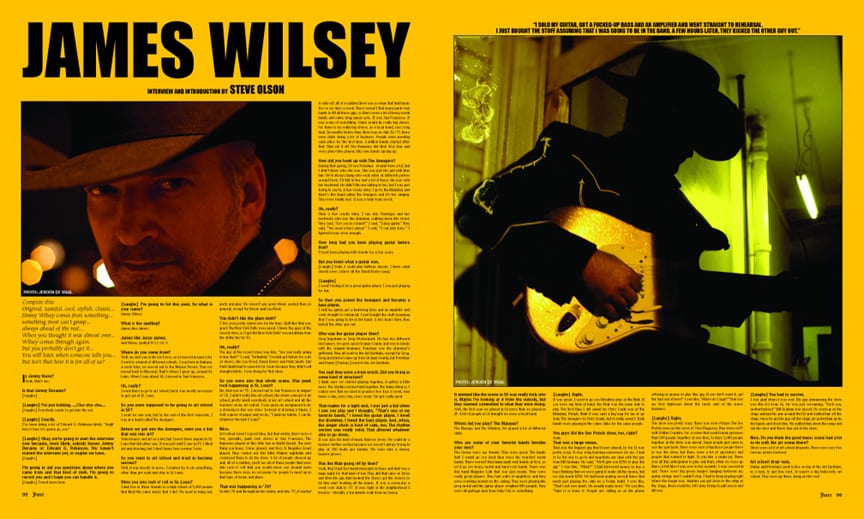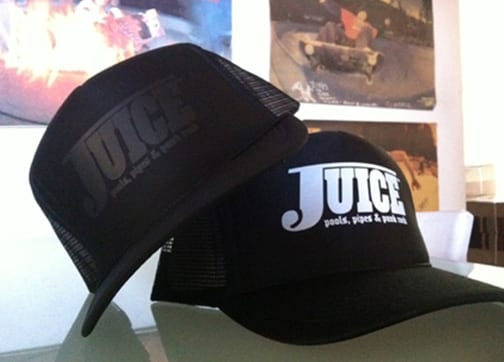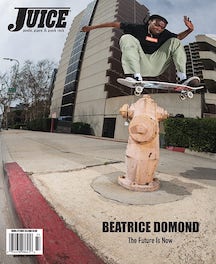INTERVIEW WITH JAMES WILSEY OF THE AVENGERS
INTERVIEW AND INTRODUCTION BY STEVE OLSON
PHOTOS BY JEROEN DE WAAL
Compute this: Original, tasteful, cool, stylish, classic… Jimmy Wilsey comes from something… something most can’t grasp… always ahead of the rest… When you thought it was almost over… Wilsey comes through again, but you probably don’t get it… You will later, when someone tells you… but isn’t that how it is for all of us?
Is Jimmy there?
Yeah, that’s me.
Is that Jimmy Durante?
[Laughs]
“THE SHOW WAS PRETTY CRAZY. THERE WAS A LOT OF HYPE. THE SEX PISTOLS WERE ON THE COVER OF TIME MAGAZINE. THEY WERE ON TV WITH WALTER CRONKITE FOR A SCENE THAT WOULD BARELY GET MORE THAN 500 PEOPLE TOGETHER AT ONE TIME. TO HAVE 5,000 PEOPLE TOGETHER AT THAT SHOW WAS UNREAL.”
[Laughs] I’m just kidding. …Cha-cha-cha…
[Laughs] Everybody wants to get into the act.
[Laughs] Exactly.
I’ve been doing a lot of Edward G. Robinson lately. “Argh! Here’s how its gonna go, see.”
[Laughs] Okay, were going to start the interview now because, most likely, nobody knows Jimmy Durante or Edward G. Robinson. We haven’t started the interview yet, or maybe we have.
[Laughs]
I’m going to ask you questions about where you came from and that kind of stuff. I’m going to record you and I hope you can handle it.
[Laughs] I need more beer.
[Laughs] I’m going to hit this joint. So what is your name?
Jimmy Wilsey.
What is the spelling?
James like James.
James like Jesse James.
Wilsey spelled W-I-L-S-E-Y.
Where do you come from?
Well, my dad was in the Air Force, so we moved around a lot. I went to a bunch of different schools. I was born in Indiana. A week later, we moved out to the Mojave Desert. Then we moved back to Missouri. That’s where I grew up, around St. Louis. When I was about 18, I moved to San Francisco.
Oh, really?
I went there to go to art school, but it was mostly an excuse to get out of St. Louis.
So you were supposed to be going to art school in SF?
I went for one year but, by the end of the first semester, I was in a band called The Avengers.
Before we get into the Avengers, were you a kid that was into art?
I liked music and art as a kid, but I never knew anyone in St. Louis that did either one. It was just stuff I saw on TV. I liked art and drawing, but I don’t know how serious I was.
So you went to art school and tried to become serious?
Well, it was mostly to move. I wanted try to do something, other than get a job and stay in St. Louis.
Were you into rock n roll in St. Louis?
I had two or three friends in a high school of 5,000 people that liked the same music that I did. We used to hang out, party and play. We weren’t any good. Music sucked then, in general, except for Bowie and Lou Reed.
You didn’t like the glam stuff?
T. Rex was pretty subversive for the time. Stuff like that was good. The New York Dolls were great. I knew the guys at the record store, so I got the New York Dolls second album from the dollar bin for $1.
Oh, really?
The guy at the record store was like, “Are you really going to buy that?” I said, “Definitely.” I would get tickets for a lot of shows, like Lou Reed, David Bowie and Patti Smith. But Patti Smith had to cancel in St. Louis because they didn’t sell enough tickets. I was living for that show.
So you were into that whole scene. Was punk rock happening in St. Louis?
No, that was in ’75. I moved out to San Francisco in August of ’76. I didn’t really like art school, the whole concept of art school, pretty much everybody at my art school and all the teachers at my art school. I was given an assignment to do a drawing in this one class. Instead of drawing a figure, I took a piece of paper and wrote, “I paid my tuition. I can do whatever I want.”
Nice.
Art school wasn’t a great time, but that winter there were a few, sporadic, punk rock shows in San Francisco. The Ramones played at this little bar in North Beach. The next thing you know, Crime played, and Rozz and Negative Trend played. They rented out this little Filipino nightclub and convinced them to do the show. A lot of people showed up and, all of a sudden, you’d see all of these people that were into rock n’ roll that you would never see around town because there were no occasions for people to meet up in that type of forum and place.
That was happening in ’76?
In late 76 and throughout the winter, and into 77, it started to take off. All of a sudden, there was a venue that had bands five or six days a week. There weren’t that many punk rock bands to fill all those gigs, so there were a lot of heavy metal bands and some drag queen acts. It was San Francisco. It was a mix of everything. Crime would do really big shows. For them to do really big shows, as a local band, was a big deal. Six months before that, there was no club. By 77, there were clubs doing a lot of business. People were meeting each other for the first time. A million bands started after that. That set it off. The Ramones did their first tour and every place they played, fifty new bands sprung up.
How did you hook up with The Avengers?
During that spring, I’d see Penelope around town a lot, but I didn’t know who she was. She was just the girl with blue hair. We’d always bump into each other at different parties around town. I’d talk to her and a lot of times she was with her boyfriend. He didn’t like me talking to her, but I was just trying to say hi. A few weeks later, I go to the Mabuhay and there’s this band called The Avengers and it’s her singing. They were totally lost. It was a total train wreck.
Oh, really?
Then a few weeks later, I ran into Penelope and her boyfriend, who was the drummer, walking down the street. They said, “Are you in a band?” I said, “I play guitar.” They said, “We need a bass player.” I said, “I can play bass.” I figured it was close enough.
How long had you been playing guitar before that?
I’d just been playing with friends for a few years.
But you knew what a guitar was.
[Laughs] Yeah, I could play halfway decent. I knew what chords were. I knew all the David Bowie songs.
[Laughs]
I wasn’t trying to be a great guitar player. I was just playing for fun.
So then you joined the Avengers and became a bass player.
I sold my guitar, got a bass and an amplifier and went straight to rehearsal. I just bought the stuff assuming that I was going to be in the band. A few hours later, they kicked the other guy out.
Who was the guitar player then?
Greg Ingraham or Greg Westermark. He has two different last names. He grew up in Orange County and was in bands with the original drummer. Penelope was the drummer’s girlfriend. They all went to the Art Institute, except for Greg. Greg just kind of came up from Orange County, but Penelope and Danny [Furious] went to the Art Institute.
You said they were a train wreck. Did you bring in some kind of structure?
I think, once we started playing together, it gelled a little more. The rhythm section held together. The funny thing is, I realize now that we used to practice five days a week, four hours a day, every day, every week. We got really good.
That makes for a tight unit. I was just a kid when I saw you play and I thought, “That’s one of my favorite bands.” I loved the guitar player. I loved the drummer. I loved the bass player. And, whoa, the singer chick is kind of cute, too. The rhythm section was really solid. That allowed whatever else to go down.
It was also the kind of music that we wrote. We could do a heavier rhythm section because we weren’t always trying to play at 250 beats per minute. We were into a slower, heavier groove.
Was the Mab going off by then?
Yeah. They’d get two hundred people in there and that was a huge night for that kind of bar. They did that once or twice and then the guy that booked the shows got the owners to let him start booking all the bands. It was a seven-day a week rock club in 77. It was right in the neighborhood that I lived in – literally, a ten-minute walk from my house.
It seemed like the scene in SF was really truly into it. Maybe I’m looking at it from the outside, but they seemed committed to what they were doing.
Well, the first year we played in LA more than we played in SF. A lot of people in LA thought we were a local band.
Where did you play? The Masque?
The Masque and The Whiskey. We played a lot of different clubs.
Who are some of your favorite bands besides your own?
The Germs were our friends. They were great. The bands that I would go see back then were the weirdest metal bands. There weren’t that many punk rock bands at first, so we’d go see heavy metal and hard rock bands. There was this band Magister Ludi that was just insane. They were really great players. They had walls of amplifiers and they were crawling around on the ceiling. They were playing like prog metal and the guitar player weighed 400 pounds. They were all garbage men from Daily City or something.
[Laughs] Right.
It was great. I used to go see Metallica play at the Mab. If you were any kind of band, the Mab was the main club to play. The first time I did sound for Chris Isaak was at the Mabuhay. People think it was such a big leap for me to go from The Avengers to Chris Isaak, but it really wasn’t. Both bands were playing in the same clubs for the same people.
You guys did the Sex Pistols show, too, right?
Yeah.
That was a large venue.
That was the biggest gig they’d ever played, by far. It was pretty crazy. It was a big learning experience for me. I had to be the one to go in and negotiate our deal with the guy from Bill Graham. He said, “We’ll give you $250 to play the gig.” I was like, “What?” I had borrowed money to buy a bass thinking that we were going to make all this money, but we only made $250. We had been making several times that much just playing the club on a Friday night. I was like, “That’s not very much. We usually make more.” He was like, “Take it or leave it. People are calling us on the phone offering us money to play this gig. If you don’t want it, get out of here!” I was like, ‘Where do I sign?” That was my first big lesson about the nasty side of the music business.
[Laughs] Right.
The show was pretty crazy. There was a lot of hype. The Sex Pistols were on the cover of Time Magazine. They were on TV with Walter Cronkite. For a scene that would rarely get more than 500 people together at one time, to have 5,000 people together at the show was unreal. Some people just came to see the spectacle. There were a lot of hardcore people there to see the show, but there were a lot of spectators and people that wanted to fight. It was like a snake pit. There was all this anticipation to play and then, while we were up there, it felt like it was over in ten seconds. I was covered in spit. There were big green lugies hanging between my guitar strings and I couldn’t stop. I had to keep playing right where the lugie was. Anytime you got close to the edge of the stage, there would be 100 arms trying to pull you in and kill you.
[Laughs] You had to survive.
I was glad when it was over. The guy announcing the show was this DJ from LA. He was just screaming profanity. Bill Graham was pissed. He went up on the stage and put his arm around the DJ and walked him off the stage. Once he got the guy off the stage, he picked him up by the lapels and shook him. He walked him down the ramp and out the door and threw him out of the show.
Nice. Do you think the good music scene had a lot to do with the art scene there?
There were a lot of art school dropouts. There were very few serious artists involved.
Art school drop-outs.
Danny and Penelope used to live on top of the Art Institute, in a tent, to get free rent. It wasn’t a big hoity-toity art school. They were up there, living on the roof.
Why did you guys break up?
At some point, the original guitar player left, so we got another guitar player. We continued on for a while and wrote some good songs, but the band had changed. The scene seemed to be dying out. A lot of people burned out and stopped going out. There was a second wave of stuff coming up, like the Dead Kennedys, and the crowds were different. It started becoming a punk uniform thing. I remember when The Avengers played, there were always people moshing around but, if there was a real fight, we’d always stop playing until they broke it up. By ‘79, bands were encouraging people to fight. You started getting a whole different crowd and they’re not really much fun to talk to.
They just want to fight.
The whole thing started changing. After the first year of the band, I doubt we listened to any punk rock music at our house. It was all rockabilly or country music. I got into rockabilly in a big way, even though I didn’t really have the aptitude to play it.
It seems like rockabilly was the next thing.
It was all happening before the Stray Cats. Early on in the scene, half of the people in the audience were in bands. If you messed up on stage, everyone knew it. I remember Billy Zoom from X had been into rockabilly since the late ’60s, when he played with Gene Vincent. He was staying at our guitar player’s house when they had a gig up here with us. He was playing Gene Vincent stuff, just like the record. He was playing Elvis Sun Sessions stuff just like the record. I remember him playing Eddie Cochran, sitting in the balcony. He knew all the intros and turnarounds, just like the record. I thought, “That’s not even possible.” Then I was watching him do it and I was thinking, “Oh, that’s not hard. I want to do that.”
FOR THE REST OF THE STORY, ORDER ISSUE #63 BY CLICKING HERE…
SHARE THIS POST:
- Click to email a link to a friend (Opens in new window)
- Click to share on Tumblr (Opens in new window)
- Click to share on LinkedIn (Opens in new window)
- Click to share on Pinterest (Opens in new window)
- Click to share on Twitter (Opens in new window)
- Click to share on Facebook (Opens in new window)
- Click to share on Reddit (Opens in new window)
- Click to print (Opens in new window)











